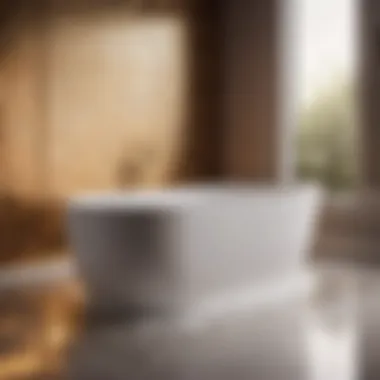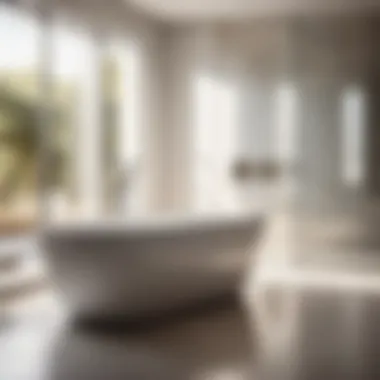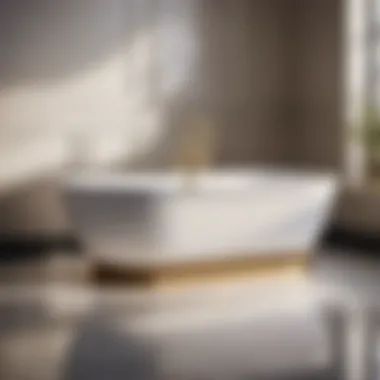Unveiling the Crucial Role of Bathroom Tub Floor Trim in Enhancing Functionality and Aesthetics


Materials:
- Silicone sealant: 2 tubes (each measuring 10 oz) for water resistance
- Trim molding: PVC material, 1 piece measuring 60 inches in length
- Caulk gun: for precise application of sealant
- Sandpaper: medium grit for smoothing edges
- Cleaning solution: to ensure surface is free of debris
DIY Steps:
- Begin by measuring the length of your bathtub edge to determine the required length of trim molding.
- Cut the trim molding to size using a fine-tooth saw for accuracy.
- Sand down any rough edges on the trim molding to create a smooth finish.
- Clean the bathtub edge thoroughly to remove any dirt or grime that may affect adhesion.
- Apply a continuous bead of silicone sealant along the bottom edge of the bathtub.
- Press the trim molding firmly into the sealant, ensuring a secure bond.
- Wipe away any excess sealant with a damp cloth for a polished look.
Technical Aspects:
- Tools: Caulk gun, saw, sandpaper
- Timing specifics: Allow 24 hours for the sealant to fully cure
- Critical techniques: Ensure the sealant is applied evenly for a watertight seal
DIY Project Process:
- Installation method: Secure trim molding with silicone sealant for durability
- Key techniques: Press firmly to ensure proper adhesion
- Timings: Allow sufficient time for sealant to cure
Troubleshooting Tips:
- If trim molding does not adhere properly, reapply silicone sealant and press firmly
- Ensure trim molding is cut accurately to fit the bathtub edge
Introduction
In the realm of bathroom design and renovation, every little detail plays a crucial role in not only enhancing the visual appeal but also in ensuring the functionality of the space. One such integral element that often goes unnoticed but holds significant importance is the bathroom tub floor trim. This unassuming feature serves as the finishing touch that ties the entire bathroom aesthetic together while offering practical benefits that go beyond just aesthetics.
When we talk about the importance of bathroom tub floor trim, we are delving into a world where form meets function seamlessly. The trim around the base of the tub not only elevates the overall look of the bathroom but also plays a vital role in protecting the structural integrity of the flooring and preventing water damage. By acting as a barrier against moisture seepage, the floor trim helps in maintaining a clean and dry environment, thus prolonging the lifespan of both the tub and the floor.
Moreover, the aesthetic aspect of the tub floor trim should not be underestimated. It serves as a defining element that can complement the existing design style of the bathroom or add a touch of sophistication and elegance, depending on the material and design chosen. Whether it is a sleek modern look with metal trim or a rustic vibe with wooden trim, the options are vast and cater to a myriad of design preferences.
Importance of Bathroom Tub Floor Trim
Bathroom tub floor trim plays a crucial role in both the functionality and aesthetics of a bathroom space. Understanding the importance of this detail is essential for anyone looking to enhance their bathroom's overall appeal and durability. By focusing on specific elements such as enhancing aesthetics, protecting against water damage, and ensuring easy maintenance and cleaning, the significance of bathroom tub floor trim becomes evident.


Enhancing Aesthetics
Choosing the Right Material
In the realm of bathroom tub floor trim, selecting the appropriate material is paramount. The choice of material not only influences the overall look of the bathroom but also contributes to the trim's longevity and functionality. Opting for high-quality materials such as stainless steel, aluminum, or PVC can enhance the aesthetics of the bathroom while also providing durability and resistance to moisture. The right material choice ensures that the trim complements the design theme of the bathroom, elevating its visual appeal.
Matching Trim with Bathroom Style
Apart from choosing the right material, matching the trim with the existing bathroom style is essential for a cohesive look. Whether the bathroom features a modern, traditional, or eclectic design, the trim should seamlessly integrate with the decor scheme. Coordinating the trim with the color palette, fixtures, and overall ambiance of the bathroom enhances the visual harmony of the space. This careful selection adds a finishing touch that ties the elements of the bathroom together, creating a polished and cohesive aesthetic.
Protecting Against Water Damage
Preventing Moisture Seepage
One of the primary functions of bathroom tub floor trim is to prevent moisture seepage and water damage. Choosing trim with effective sealing properties and a moisture-resistant design helps create a barrier against water infiltration. By selecting trim that offers optimal protection against moisture, homeowners can safeguard their bathroom floors and walls from potential water-related issues, such as mold growth and structural damage.
Maintaining Structural Integrity
In addition to protecting against moisture, bathroom tub floor trim also plays a role in maintaining the structural integrity of the bathroom. High-quality trim materials and proper installation techniques contribute to the longevity and stability of the bathroom space. Trim that is designed to withstand humidity and frequent water exposure ensures that the structural components of the bathroom remain intact over time, providing a solid foundation for the overall integrity of the room.
Easy Maintenance and Cleaning
Resisting Mold and Mildew
An important aspect of bathroom tub floor trim is its ability to resist mold and mildew growth. Mold and mildew thrive in damp environments, making bathrooms particularly vulnerable to these issues. Choosing trim materials that are specifically designed to resist mold and mildew helps maintain a hygienic and visually appealing bathroom environment. By minimizing the risk of mold infestations, homeowners can ensure a clean and healthy space.
Simplifying Cleaning Routine
Effortless maintenance is another advantage of well-chosen bathroom tub floor trim. Opting for trim that is easy to clean and requires minimal upkeep can streamline the overall cleaning routine. Smooth surfaces, resistant to stains and grime, make cleaning the bathroom a simple task. By selecting trim that simplifies the cleaning process, homeowners can enjoy a bathroom space that remains fresh and tidy with minimal effort.
Types of Bathroom Tub Floor Trim
In this article, the discussion now turns to the crucial topic of Types of Bathroom Tub Floor Trim. Understanding the various options available for bathroom tub floor trim is essential for achieving the desired functionality and aesthetic appeal in your bathroom space. Each type of trim offers distinct benefits and considerations that homeowners need to carefully evaluate.


Tile Edge Trim
Tile edge trim is a popular choice for many homeowners due to its sleek and modern look. This type of trim provides a clean finish to tiled surfaces, protecting the edges of the tiles from chipping or damage. Additionally, tile edge trim helps create a seamless transition between different materials or areas in the bathroom, enhancing the overall design aesthetic. When selecting tile edge trim, it is important to consider factors such as material durability, color options, and profile styles to complement your existing bathroom decor.
Wooden Floor Trim
Wooden floor trim adds a touch of warmth and elegance to the bathroom space. It is a versatile option that can be stained or painted to match your preferred style. Wooden trim offers a natural and organic look, perfect for creating a cozy and inviting atmosphere in the bathroom. However, homeowners should be cautious with wooden trim in wet areas, as moisture exposure can lead to warping or mold growth. Proper sealing and maintenance are crucial to ensure the longevity of wooden floor trim.
Metal Trim Options
Metal trim options, such as stainless steel or aluminum, are ideal for homeowners looking for a modern and durable solution. Metal trims are water-resistant and easy to clean, making them a practical choice for high-moisture environments like the bathroom. These trims add a sleek and contemporary touch to the space, enhancing its overall sophistication. Consider the finish, thickness, and corrosion resistance of metal trims when selecting the most suitable option for your bathroom.
Vinyl and PVC Trim
Vinyl and PVC trims are cost-effective and versatile options for bathroom tub floor trim. These materials are waterproof, lightweight, and easy to install, making them a popular choice for DIY enthusiasts. Vinyl and PVC trims come in a variety of colors and textures, allowing homeowners to customize their bathroom decor effortlessly. While these trims offer convenience and affordability, they may lack the visual appeal and long-term durability of other materials. Carefully assess your priorities and budget to determine if vinyl or PVC trim is the right choice for your bathroom space.
Factors to Consider When Choosing Floor Trim
When it comes to selecting the ideal floor trim for your bathroom tub, several crucial factors must be taken into consideration to ensure functionality, aesthetics, and longevity. Understanding these essential elements can lead to a successful and satisfying bathroom renovation or upgrade.
Durability and Water Resistance
Durability and water resistance stand out as key factors when choosing floor trim for the bathroom tub area. The materials used in the trim must be able to withstand constant exposure to moisture, water splashes, and the humid environment of the bathroom. Opting for materials such as PVC, vinyl, or metal that have high water resistance properties can significantly extend the lifespan of the trim.
Installation and Maintenance
Another vital consideration is the ease of installation and maintenance of the chosen floor trim. Homeowners often prefer trims that are easy to install without the need for extensive professional help. Additionally, the trim should be low-maintenance, requiring minimal effort to keep it clean and in good condition. Prioritizing trim options that are simple to install and easy to maintain can save time and effort in the long run.
Design and Style Compatibility
Apart from functionality, the design and style of the floor trim play a significant role in enhancing the overall aesthetics of the bathroom space. Selecting a trim that complements the existing design scheme of the bathroom, whether it's modern, traditional, or minimalistic, can tie the room together seamlessly. Coordinating the trim with other bathroom elements such as tiles, fixtures, and decor helps create a cohesive and visually appealing look.


Installation Process of Bathroom Tub Floor Trim
The installation process of bathroom tub floor trim is a crucial step in enhancing the overall look and functionality of your bathroom space. Properly installed trim not only adds a polished finish to the tub area but also provides essential protection against water damage and structural wear. It plays a vital role in tying together the design elements of your bathroom, creating a cohesive and appealing look.
Preparation Steps
Before starting the installation process, it is essential to thoroughly prepare the area for the trim. Begin by cleaning the tub surface to remove any dirt, grime, or remnants of old trim. Ensure the substrate is in good condition, free of cracks or uneven surfaces that could affect the trim's adhesion. Measure the dimensions accurately to cut the trim to fit precisely around the tub.
To prevent moisture seepage and ensure a secure fit, apply a waterproof sealant around the tub edges. This preparatory step is crucial for maintaining the integrity of the trim and preventing water damage over time. Allow the sealant to dry completely before proceeding with the installation.
Trim Cutting and Fitting
The next step in the installation process involves cutting the trim to the correct size and fitting it around the tub. Use a precise measurement tool to ensure accurate cutting, avoiding any gaps or overlaps that could compromise the trim's integrity. Follow the manufacturer's instructions for cutting the trim material, whether it be tile, wood, metal, vinyl, or PVC.
Fit the cut trim pieces around the tub edges, ensuring a snug and even placement. Pay attention to the alignment and spacing to achieve a seamless look. Trim cutting and fitting require precision and patience to create a professional finish that complements your bathroom decor.
Securing the Trim in Place
Once the trim pieces are cut and fitted correctly, secure them in place using the recommended adhesive or fastening method. Ensure that the trim is firmly attached to the tub surface, with no loose edges or gaps that could trap water and lead to damage. Use appropriate tools and techniques to secure the trim securely and evenly along the tub perimeter.
Properly securing the trim in place not only enhances the aesthetic appeal of your bathroom but also ensures its longevity and performance. Regularly inspect the trim for any signs of loosening or damage, and address any issues promptly to maintain its effectiveness in protecting against water intrusion and preserving the beauty of your bathroom space.
Avoiding Harsh Cleaning Agents
While cleaning your bathroom tub floor trim, it's essential to avoid harsh cleaning agents that can damage the material and finish of the trim. Opting for gentle cleaning solutions will help preserve the integrity of the trim while effectively removing dirt and grime.
Harsh chemicals such as bleach, ammonia, or abrasive cleaners can cause discoloration, warping, or deterioration of the trim over time. Instead, consider using mild soaps, white vinegar, or pH-neutral cleaners to clean the trim effectively without causing harm.
Before using any new cleaning product on the trim, test it on a small, inconspicuous area to ensure compatibility with the material. Avoid abrasive scrubbing pads or brushes that can scratch or damage the surface of the trim.
By choosing gentle cleaning agents and treating the trim with care, you can maintain its pristine condition and extend its lifespan, keeping your bathroom looking beautiful and well-maintained.
Conclusion
In this meticulous exploration of the importance of bathroom tub floor trim, we have unveiled the critical role that this often-overlooked element plays in both the functionality and aesthetic appeal of a bathroom space. As we conclude this comprehensive guide, it becomes evident that bathroom tub floor trim is not merely a finishing touch but a vital component that enhances the overall look and performance of the bathroom. By choosing the right floor trim, homeowners can significantly elevate the visual aspect of their bathrooms while also ensuring practical benefits such as water damage prevention and easier maintenance.
Throughout this article, we have discussed various aspects of bathroom tub floor trim, starting from understanding its significance in enhancing aesthetics to its ability to protect against water damage. By delving into different types of trim options and factors to consider when selecting the most suitable one, we have provided in-depth insights for readers looking to upgrade their bathroom spaces. The installation process and maintenance tips covered in preceding sections further underscore the importance of proper care and attention to detail when it comes to bathroom tub floor trim.
In essence, the significance of bathroom tub floor trim lies in its ability to tie together the design elements of a bathroom while serving a functional purpose. Whether it's tile edge trim, wooden floor trim, metal options, or vinyl and PVC choices, the right trim can transform a mundane bathroom into a stylish and well-protected sanctuary. By keeping in mind considerations such as durability, maintenance, and design compatibility, homeowners can make informed decisions that will enhance the longevity and visual appeal of their bathroom spaces. Thus, the meticulous selection and care of bathroom tub floor trim are crucial steps in creating a beautiful and functional bathroom that homeowners can enjoy for years to come.







